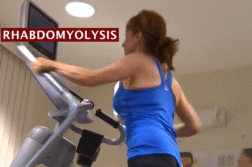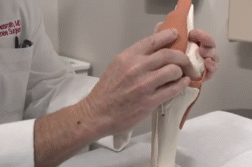Brian Shiple, DO, orthopedic specialist at The Center for Sports Medicine talks about a new treatment, called Discseel, that provides relief for patients, like Neil Bar, with chronic back pain.
Interview conducted by Ivanhoe Broadcast News in January 2022.
For a lot of patients, does Discseel solve the problem, or does it extend that time before they need surgical measures?
SHIPLE: In some cases, it’s an excellent long-term management tool where we may have to do treatments down the road maybe, once a year, or once every two or three years. But the problem in the disc of our patients is that an injury occurs, and it can be degenerative, or an acute car accident, or fall at work, or something like that, and they tear their disc. That tear is called an annular tear and the annulus does not have a good blood supply and it has poor potential to heal on its own. So, patients have years of chronic pain, it’s difficult to prove, it’s not seen commonly with an MRI, and we have a high clinical suspicion that they have this. Once we get into treating it, we prove they have it with an injection of dye that we can see on an x-ray, and then, we know they have a tear. We don’t know if it’s symptomatic or not, but we have developed a program where we treat all the tears and we end up treating the symptomatic ones, as well as ones that may become symptomatic in the future. My patients will say that their years of a fragile back, they are careful, because their back may go out on them periodically, not that all goes away. When they heal, their backs become sturdy and the comment I love to hear from my patients after years of chronic pain is, ‘I don’t think about my back anymore.’ That’s exciting and, am I curing their back condition? Not necessarily, but I’m healing that tear. We have evidence of that in our cases and in the literature.
Can you explain what Discseel is?
SHIPLE: Sure. When you look at our field of regenerative medicine and how doctors have been treating the spine with things like platelet-rich plasma or bone marrow concentrate, a physician that invented the Discseel procedure had the novel idea of using an off-the-shelf vial of a protein, called fibrinogen used for 25 years in surgery to help seal things when the surgeons are cutting to the bowel or a heart valve. They use this, it becomes like a thick glue that they use to seal things instead of reinforcing sutures. He had the novel idea, and he really proved the concept. In an annular tear in many of our patients that are symptomatic, the tear is leaking. It’s leaking an inflammatory chemical out into the nerve area that causes our patients pain and if he could seal that tear and stop that leak, he could stop the patient’s nerve pain. What he found and proved in research was that not only was he sealing these tears, but they were healing. So, he started using it in clinical practices. He did a lot of research with it and he has proven that by sealing these tears, he’s getting these patients to heal their tears. That has been a game changer. Everything else in our regenerative medicine field does not address that annular tear in stopping that leak. He’s the first one that started doing that and it’s been a successful program. I trained with him and had it done to my discs and it helped me greatly.
Can you describe the steps that you would have to take? Is it a one-time injection for patients? How does that work?
SHIPLE: Most of the things that we do to the disc, it’s usually what I like to call a ‘one and done’. The needle is placed in the disc, first and then, dye is injected in to confirm there’s a tear. If there’s no tear, it doesn’t get treated. We pull the needle back to the edge of the disc, and the needle hole is sealed, and we get out. We don’t want to leave a needle hole into the disc. But if there is an annular tear there, then it gets treated. The treatment is just injecting this combination of a few different drugs, but the main one is this glue-like fibrinogen that’s turned into like hard Silly Putty once it’s activated. That sealant is very sturdy to the disc, so the patient can return activity very quickly. Not sports activity but return to life very quickly.
How long have you been using this? When was it FDA approved?
SHIPLE: It’s not FDA approved. There was some FDA involvement in research projects with the developer, Dr. Pauza, and unfortunately, the FDA asked Dr. Pauza to change the technique that he was used to and proved in research how it worked. It’s complicated, but he knew that if he changed the protocol to the way the FDA wanted him to, it would not hold up in the research. And it didn’t. So, he backed away from the FDA research and continued doing what he had proved in his research, and he’s been doing that ever since. Now, he’s training physicians, like me, around the country and they’re building a sizable network of capable practitioners that can offer this to their patients.
Is it considered experimental or how would you describe it?
SHIPLE: It is. Yes, it’s not FDA approved. It’s still considered an experimental procedure, but it has strong data behind it showing that it works.
Can you talk to me a little bit about Neil’s case?
SHIPLE: Neil came to me 15 years ago as an Ironman triathlete. He was a young man, in his 30s, and he had a congenital condition where his bottom vertebra was slipped; we call it a listhesis, it’s one vertebra slipped forward on the other, and that creates instability at that disc level. That disc degenerated, herniated, was torn, and was unstable. I did stabilizing treatments with injections, using things like dextrose, prolotherapy and PRP to stabilize his ligaments, which helped his pain. He was able to train and compete, and before I treated him, he was having great difficulty training. So, I was able to get him back to training, but he always had some pain in his lower back. As we got to know each other and other injuries popped up, I started talking to him about the promise of the Discseel procedure, because I knew it was out there, but I wasn’t using it until more recently. I was skilled at putting needles in the disc, it’s just adding this medication was new to me. I told Neil that we could put that on the list, and within two weeks, he was training again. The developer of the procedure does not want his athletes training two weeks after the procedure, it’s more like six months after, just to be careful. But a lot of my athletes will take what I say with a grain of salt and do what they want to do. Neil was doing great. At the two-month mark, he was pain free and training hard. When I see him for another problem, I’ll casually ask him how his back’s doing and he’ll say, ‘I don’t even think about it anymore’.
How many patients have you treated with it?
SHIPLE: About 50.
Does insurance cover Discseel because it is experimental?
SHIPLE: No.
What is the out-of-pocket cost?
SHIPLE: So, as a licensed provider, we’re all licensed to charge the same amount. The licensed cost to do this procedure is $14,500 and then most practices do this under conscious sedation, and the conscious sedation is an extra fee of around $1,000. But for people who are in chronic pain, I think it’s a value. I’m involved in a practice in Delaware that treats a lot of spine injured patients in a worker’s comp panel.
END OF INTERVIEW
This information is intended for additional research purposes only. It is not to be used as a prescription or advice from Ivanhoe Broadcast News, Inc. or any medical professional interviewed. Ivanhoe Broadcast News, Inc. assumes no responsibility for the depth or accuracy of physician statements. Procedures or medicines apply to different people and medical factors; always consult your physician on medical matters.
If you would like more information, please contact:
Brian Shiple, DO
Sign up for a free weekly e-mail on Medical Breakthroughs called First to Know by clicking here




